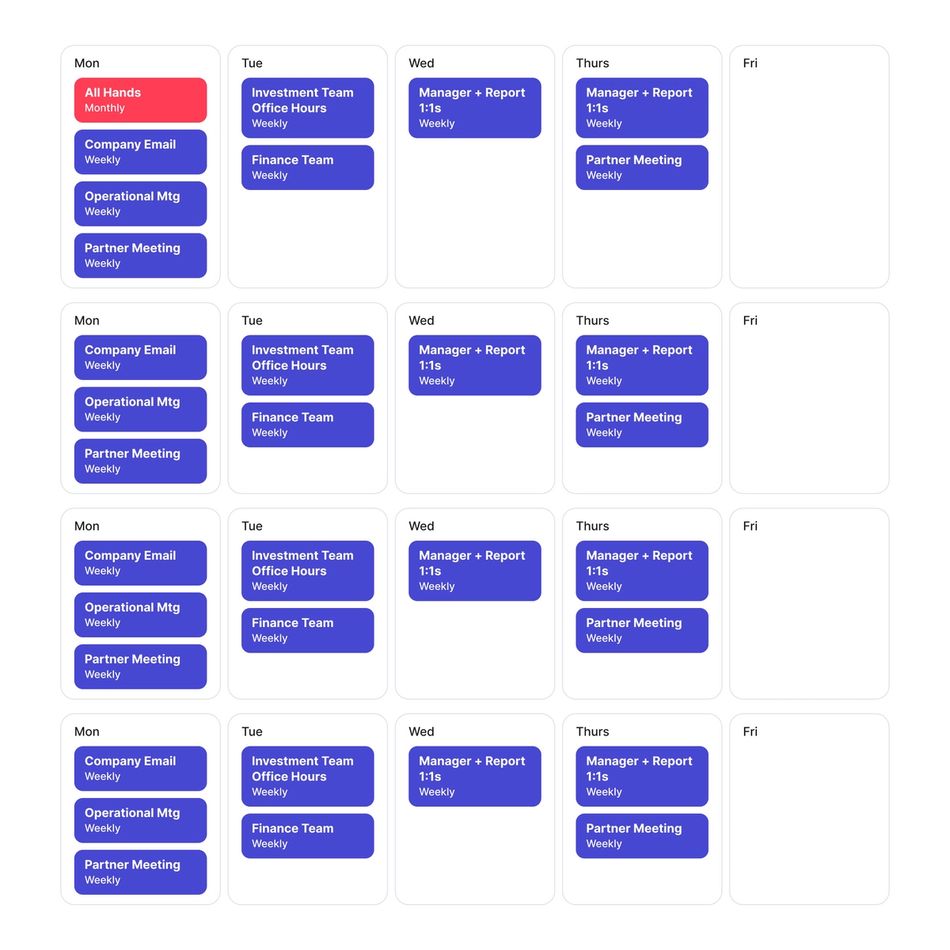Leading a team, especially a distributed or growing one, can be hard. Oftentimes the best advice and ideas come from other teams just like yours. That’s why we launched Lead Time: How Teams Work. This blog series profiles real teams, how they’re structured, and how they communicate through meetings and other touch points. Plus, each article features a top-notch leader who's got proven tips and real stories to learn from.
Meet Brett Berson, Partner at First Round
Brett Berson is a partner at First Round Capital — a VC firm focused on investing early to help founders build companies from scratch. He’s responsible for a team of about 40, focused on investment, finance, founder services, and more.
We sat down with Brett to learn how First Round handles meetings and communication when their work is spread across so many different areas, and learn his top tips for leading a fast-growing team.
How the team works
Team structure
About 40 team members make up First Round, which consists of three main groups — an investing team, an operating team, and a finance team.
Team meetings and communication cadence
Here’s a look at the weekly meetings and asynchronous touchpoints that happen at First Round.

Daily:
- The team uses Slack and email for daily quick communication.
Weekly:
- Company-wide email: The First Round team kicks off each week with a company-wide email that outlines everything going on across the business. It includes: updates from each function, recaps on hiring, a review of the companies First Round met with the previous week, and a recommended reading section with topics people might find interesting or useful. Each email leads with a big topic too, which might look like an interesting story from the past week, something that’s going on in the market, or an educational deep dive from one of the teams.
- Operational meeting: Cross-functional folks come together on Monday morning to review the status of current projects, work through blockers, and connect as a team. The 30 minute meeting moves quickly — it’s a hybrid between a stand-up and discussion format.
- Partner meetings: These meetings happen twice a week (on Mondays and Thursdays) — they’re a space to meet new companies, discuss existing companies in the First Round portfolio, and discuss general updates and information.
- Investment team office hours: Time set aside each week for folks across the org to meet with the investment team.
- Finance team meeting: Weekly team meeting for everyone in the finance org.
- Manager-report 1:1s: Weekly check-ins around in-flight work, long-term goals, and career growth.
Monthly:
- All-hands: The whole company comes together to discuss goals, strategy, company-wide updates, and wins.
Brett’s top tips for running an effective team across multiple workstreams
1. Write down your thoughts before a meeting (and encourage others to do the same)
Brett says something that’s made First Round’s meetings more effective over the years has been the idea of doing some asynchronous prep beforehand. This usually looks like a writing exercise done by everyone attending the meeting — not just the facilitator or team lead.
“For most meetings, getting people’s thoughts and ideas asynchronously ahead of time and then coming together to review them is much more effective,” shares Brett. “We’re always looking for ways to do more of our meetings in writing.”
At First Round, meetings start with a document of some kind (Brett says “it doesn’t have to be an Amazon six-pager — three paragraphs is usually just fine”) that’s shared out ahead of time so that attendees can prepare for what’s going to be discussed. Sometimes everyone shares their thoughts in writing before the meeting, and those are what shape the discussion. (This might look like feedback, brainstorm ideas, potential blockers or flags, etc.) Other times, the pre-reading and writing exercise is more about gaining alignment and clarity of thought. It forces folks to get really clear on their feedback or ideas before bringing them to the group.
Brett says doing individual async preparation also reduces biases when the team brainstorms or makes decisions together.
“Getting people to provide their ideas or feedback ahead of time, before they know what anyone else is thinking, has been exceptionally useful,” says Brett. “People love brainstorming and talking about ideas. Doing that individually, rather than as a group, is oftentimes more valuable because it reduces all the different types of bias that get put into the conversation.”
First Round has experimented with many different ways to let people ideate without letting bias or influence from others slip in. The team uses a tool called Shuffleboard for brainstorms and upvoting (it’s all anonymous and vote counts are hidden to prevent bias). He’s also known to share a Google Doc with the team, but then ask for feedback separately over email so folks won’t be influenced by other comments.
“In terms of the way that we make decisions — the ways that we're influenced by one another is so profound,” says Brett. “Reading other people's comments in a doc has its positives, but also a lot of negatives. It can change the way you think about things, particularly depending on the person who left the comment. ‘Well if Jane thinks that’s a really great idea, I should too. +1!’ — that sort of thing.”
2. Give people enough context to do their jobs well
As a fast-growing team focused on many different companies and projects all at once, Brett says it's not always easy to keep everyone aligned on everything going on at any given time. Sometimes information that seems unimportant to share with a cross-functional teammate would actually be invaluable — it’s often just hard to know.
“There’s a lot of localized knowledge and it’s not always intuitive when it’s connected,” explains Brett.
“I'm a huge believer that the more context that people have, the more effective they can be in their job,” he adds. But for Brett, context means a lot more than just sharing a link to the team’s wiki or a Google Sheet.
“Context needs to come with education too,” he shares. “The classic example is: ‘Hey, we're going to tell everyone our financials every week.’ Well, most people don't understand how a venture capital business is funded. They would look at the financials and be like, ‘Wow, our bank account is going down. That seems bad.’ without education around what the numbers mean, sharing them is kind of meaningless.”
Brett also shared that while “training and teaching and educating and explaining is in short supply in most companies” it’s something they’re actively working to change at First Round.
At First Round, some context-sharing happens asynchronously. They use Slack, email, Notion, and Google Docs to document and share important updates with the team — making it a point to share at least a brief explanation along with updates so that anyone reading them can get the full picture.
They also prioritize sharing important information in their weekly company-wide email and operational meeting — where there’s more space to offer deeper explanation and education.
Try our team leads meeting template for your next cross-functional meeting







